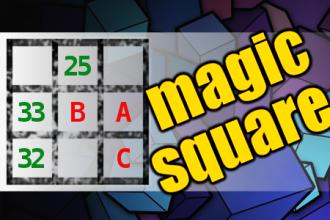MAGIC SQUARE: Calculate A*B-C
The aim is to place the some numbers from the list (2, 6, 24, 25, 31, 32, 33, 40, 41, 42, 50) into the empty squares and squares marked with A, B an C. Sum of each row and column should be equal. All the numbers of the magic square must be different. Find values for A, B, and C. Solution is A*B-C.Correct answers: 22
The first user who solved this task is Djordje Timotijevic.
#brainteasers #math #magicsquare

Funny Friday the 13th Jokes to Brighten Your Day
I don't worry about Friday the 13th.
It's bad luck to be superstitious.
Fettuccine Afraid-O.
It's bad luck to be superstitious.
On Friday the 13th, I dreamt that a horse in armor was chasing me.
It was a Knightmare.
What’s the scariest thing to do on Friday the 13th?
Check your bank account.
Read more on page: 22 Friday The 13th Jokes
Whats a good pasta to make on Friday the 13th?Fettuccine Afraid-O.
I don't have to be Freddie Krueger...
to be the man of your dreams.
Monday the 13th
sounds much worse than Friday the 13th.
Why don't mathematicians fear Friday the 13th?
Because they know it's just another irrational fear.

